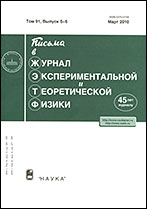|
This article is cited in 3 scientific papers (total in 3 papers)
CONDENSED MATTER
Bilayer grapheneâ–Stone–Wales graphene: structure, stability, and interlayer thermal conductivity
A. I. Podlivaev
National Research Nuclear University MEPhI (Moscow Engineering Physics Institute), Moscow, 115409 Russia
Abstract:
The interlayer thermal conductivity of two asymmetric bilayer carbon structures has been studied within the nonorthogonal tight binding model. One layer of the first structure proposed in this work for the first time is graphene and the second layer is Stone–Wales graphene, which is recently proposed carbon allotrope. The second asymmetric structure is bilayer graphene, where one layer consists of $^{12}$C isotope and the second layer consists of rarer $^{13}$C isotope. It has been shown that the interlayer thermal conductivity of asymmetric structures is more than an order of magnitude lower than that for their symmetric analogs, bilayer graphene and Stone–Wales bilayer graphene, with the same isotope composition. A high interlayer thermal conductivity of symmetric structures compared to asymmetric ones is due to the resonant interaction of phonon subsystems of individual layers (phonon spectra of individual layers in symmetric structures coincide, whereas these spectra in asymmetric structures are different). It has been shown that the graphene layer in the unstrained graphene–Stone–Wales graphene structure is flat, whereas the Stone–Wales graphene layer is corrugated. Both layers of this structure biaxially stretched by 5% become flat. The interlayer attraction energy, interlayer distance, activation energy of parallel shear of the layers, and the elastic modulus under vertical compression have been determined for unstrained and deformed structures.
Received: 31.01.2022
Revised: 17.02.2022
Accepted: 17.02.2022
Citation:
A. I. Podlivaev, “Bilayer grapheneâ–Stone–Wales graphene: structure, stability, and interlayer thermal conductivity”, Pis'ma v Zh. Èksper. Teoret. Fiz., 115:6 (2022), 384–391; JETP Letters, 115:6 (2022), 348–355
Linking options:
https://www.mathnet.ru/eng/jetpl6632 https://www.mathnet.ru/eng/jetpl/v115/i6/p384
|


| Statistics & downloads: |
| Abstract page: | 73 | | References: | 17 | | First page: | 15 |
|





 Contact us:
Contact us: Terms of Use
Terms of Use
 Registration to the website
Registration to the website Logotypes
Logotypes








 Citation in format
Citation in format 
